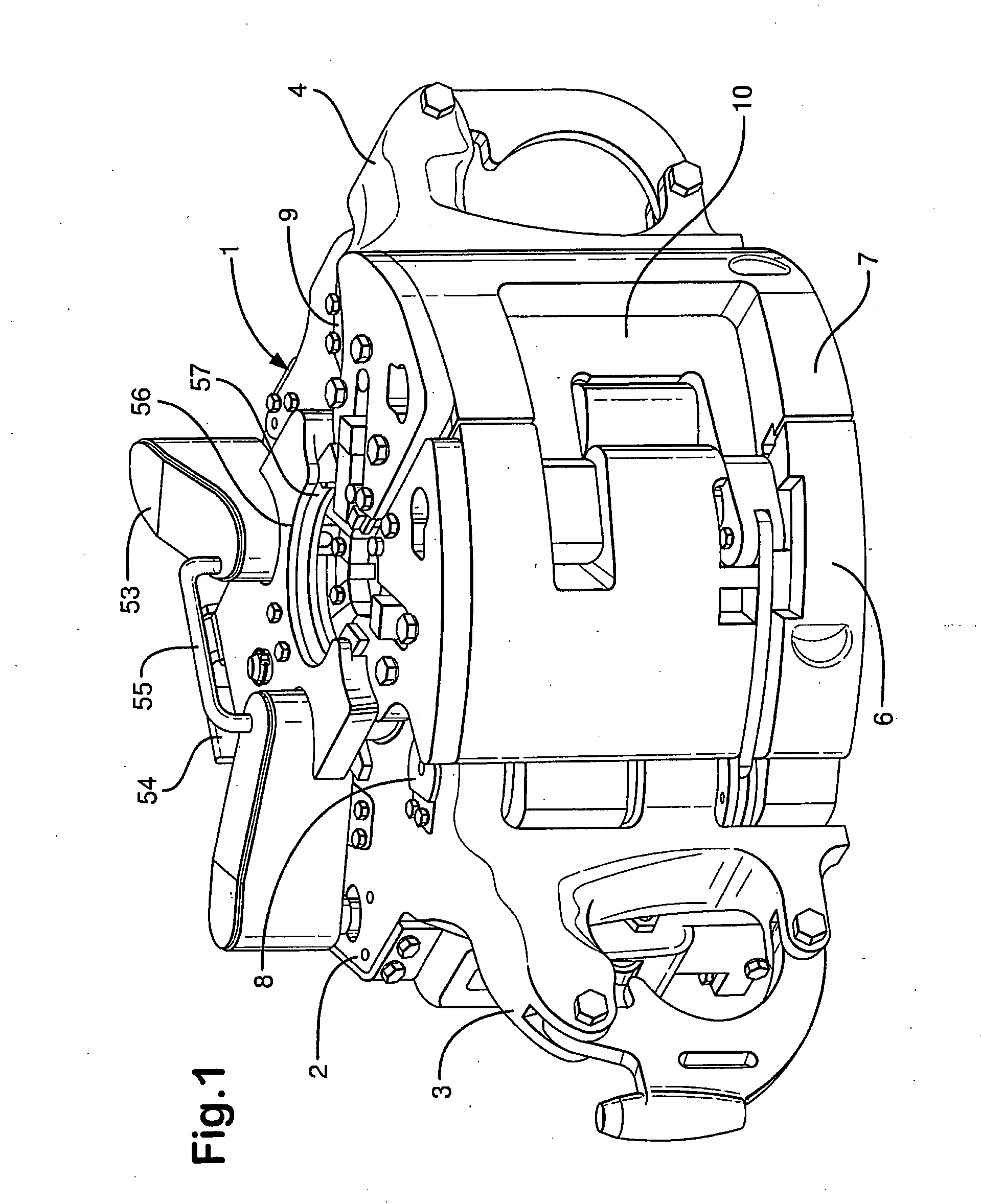[0022]The inventors have recognised that it is advantageous to have a remotely operated slip type
elevator; that hydraulic circuits are very controllable and reliable; that the elevator has to work with
top drive systems; to be able to
handle flush and near flush pipe safely; for a single elevator which, by replacing the slips with one of six sets of sips can
handle pipes which range between 2.3 / 8″-2.7 / 8″ for the first size set of slips, 2.7 / 8″-3.1 / 2″ for the second size set of slips, 3.1 / 2″-4.1 / 2″ for the third size set of slips, 4.1 / 2″-5.1 / 2″ for the fourth size set of slips, 5.5 / 8″-6.5 / 8″ for the fifth size set of slips and 6.5 / 8″-7.5 / 8″ for the sixth size set of slips.
[0024]A slip is any item which can be used to prevent or inhibit a pipe from falling through an aperture, such as the
throat of an elevator. A slip is traditionally a wedge inserted between an outer body provided with a tapering surface and the outer wall of a pipe.
[0025]Traditionally the slip tapers, although a tapering outer surface is not essential, any arms or feet which provide a tapered interface would suffice. The taper allows easy removal of the slip, which would otherwise be very difficult. The taper allows the pipe engaging surface to move radially away from the pipe, as the pipe engaging surface is designed to
resist longitudinal movement, mainly to inhibit downward slippage of a pipe or string of pipe, but also to inhibit a small amount of upward force. The slip may have a substantially planar pipe engaging surface or have concave and convex surfaces or have inserts with pipe engaging surfaces which are of varying depths which preferably conform to the outer wall of a pipe which will be held therein or the pipe engaging surface may be concave and provided with a plurality of inserts with pipe engaging surfaces. Preferably, the inserts are provided with gaps therebetween. By having a pipe engaging surface with a large contact area, the pipe engaging surface may be provided with smaller teeth or a less rough,
less invasive surface, thus the outer wall of the pipe is less likely to be damaged. This is particularly important for pipes such as premium tubulars and pipes made from brittle alloys, carbon fibre and plastics pipes. However, a planar pipe engaging surfaces may suffice, particularly, but not exclusively, if the planar pipe engaging surface is provided with teeth which bite into the outer wall of the pipe.
[0039]According to a second aspect of the invention, there is provided an apparatus for handling pipes, the apparatus comprising a body with a tapered surface, a recess in the tapered surface and a pin arranged therein, the apparatus further comprising a slip slideable on the tapered surface, wherein the slip has a lug slideable on the pin, the slip biased by resilient means between the body and the lug to bias the slip into an unset position. Preferably, this allows easy replacement of the slip by withdrawing the pin. Preferably, apparatus further comprises a shoulder arranged in the path of action of the resilient means to inhibit clamping of the lug between the resilient means and the body and preferably defining an opening between the resilient means and the body which is slightly larger than the lug to facilitate easy replacement of the slip.
[0040]Once the pin is removed, and upon removal of the slip, the lug of the slip being removed does not cause the resilient means to uncoil or decompress or to lose
stored energy. Advantageously, the apparatus further comprises a sleeve about a portion of the pin close to the lug, wherein the resilient means surrounds the sleeve. Advantageously, the sleeve is fixed to the shoulder. Preferably, the shoulder comprises a plate to lie above the resilient means and a leg upstanding from the plate. Advantageously, the body of the elevator further comprises a lug, the resilient means biased between the lug of the slip and the lug of the body of the elevator.
 Login to View More
Login to View More  Login to View More
Login to View More 


